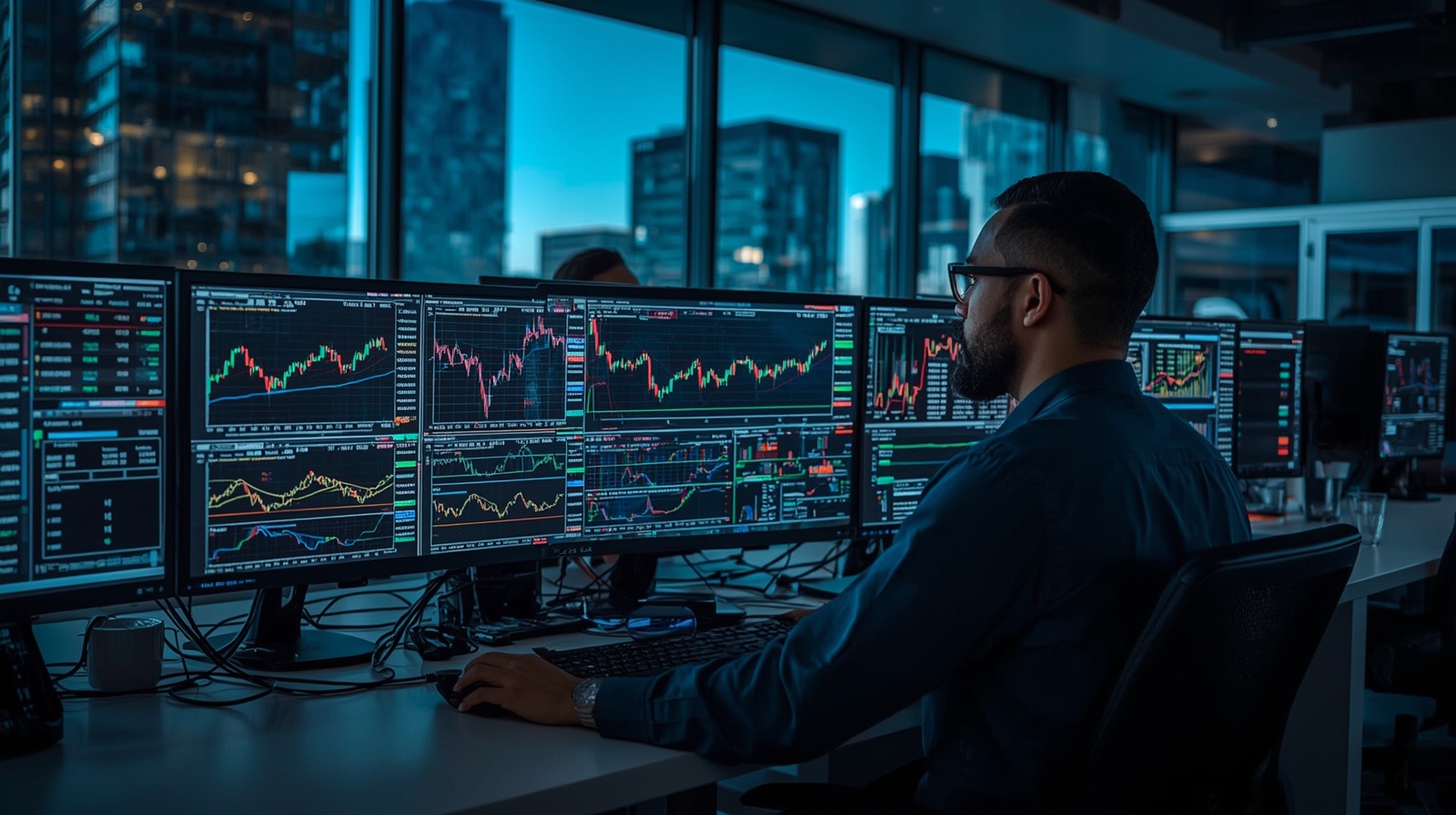1. Understanding Trading and Its Core Fundamentals
Financial markets trading is the process of buying and selling financial assets with the goal of profiting from price fluctuations. Trading relies on the fundamental principle of buying low and selling high, or vice versa in the case of short selling. Unlike long-term investing which focuses on gradual growth, trading capitalizes on rapid market price movements to achieve quick returns.
Trading encompasses the exchange of various types of financial assets such as stocks, foreign currencies (forex), commodities, cryptocurrencies, bonds, and derivatives. Each type of these assets has its unique characteristics and different risk levels.
The Difference Between Trading and Investing
| Aspect | Trading | Investing |
| Time Frame | Short to medium term | Long term |
| Objective | Quick profit generation | Gradual capital growth |
| Risk Level | High to medium | Medium to low |
| Analysis Type | Primarily technical analysis | Primarily fundamental analysis |
2. Types of Financial Markets and Their Characteristics
Stock Market
The stock market is where shares of publicly listed companies are traded. Traders can buy stocks of companies they believe will increase in price, or sell stocks they expect to decline. Stock prices are influenced by multiple factors including:
- Company financial performance
- Industry and sector news
- General economic events
- Investor sentiment
- Future analysis and forecasts
Forex Market (Foreign Exchange)
The forex market is the largest financial market in the world with daily trading volume exceeding $6 trillion. It involves trading different currency pairs such as EUR/USD, GBP/USD, USD/JPY. This market is characterized by:
- 24-hour operation, five days a week
- High liquidity
- Ability to trade with leverage
- Influence from economic and political events
Commodities Market
Includes trading of raw materials such as gold, silver, oil, natural gas, and agricultural products. Commodity prices are affected by:
- Global supply and demand
- Geopolitical events
- Weather conditions (for agricultural products)
- US dollar strength
Cryptocurrency Market
A relatively new market experiencing rapid growth, involving trading of cryptocurrencies like Bitcoin, Ethereum, and thousands of other currencies. It is characterized by:
Extreme price volatility, 24/7 operation throughout the week, and significant influence from technical and regulatory news.
3. Basic and Advanced Trading Strategies
Day Trading
Day trading is a strategy that involves opening and closing positions within the same day. Day traders aim to benefit from short-term fluctuations in asset prices. Characteristics of this strategy:
- No overnight positions held
- Requires continuous market monitoring
- Needs sufficient capital for trading
- Suitable for high-liquidity markets
Scalping
Scalping is an extreme form of day trading where traders attempt to make small profits from minor price movements. It involves:
- Opening and closing dozens or hundreds of trades daily
- Targeting small profits (usually 1-5 pips)
- Using high leverage
- Requiring speed in decision-making
Swing Trading
Involves holding positions for periods ranging from several days to several weeks, benefiting from medium-term price swings. Advantages of this strategy:
- Doesn't require continuous market monitoring
- Suitable for full-time workers
- Reduces trading costs
- Allows greater opportunity for substantial profits
Position Trading
A long-term strategy involving holding positions for months or even years, primarily based on fundamental analysis of assets.
4. Technical Analysis: Reading Market Language
Technical Analysis Fundamentals
Technical analysis is the study of historical and current price movements to predict future trends. It is based on three fundamental principles:
- The market discounts everything
- Prices move in trends
- History repeats itself
Types of Charts
Technical analysts use several types of charts:
- Line Chart: Connects closing prices with a continuous line
- Bar Chart: Shows opening, closing, high, and low prices
- Candlestick Chart: Provides clearer picture of market sentiment
Essential Technical Indicators
| Indicator | Type | Usage |
| Moving Average | Trend | Determining overall market direction |
| RSI | Momentum | Identifying overbought and oversold zones |
| MACD | Momentum | Confirming trends and trading signals |
| Bollinger Bands | Volatility | Measuring volatility and support/resistance levels |
5. Fundamental Analysis: Understanding True Value
Fundamental analysis focuses on studying economic and financial factors that affect asset values. In stock trading, this includes:
Company Financial Indicators
- Revenue and Profits: Revenue growth and profit margins
- Valuation Ratios: Such as Price-to-Earnings (P/E) ratio
- Debt and Return on Investment
- Free Cash Flow
Macroeconomic Indicators
Affect all markets and include:
- Interest rates and monetary policies
- Inflation rates and economic growth
- Employment and unemployment figures
- Trade balance and budget deficit
- Oil and commodity prices
6. Risk Management: Protecting Capital
Basic Risk Management Principles
Risk management is the backbone of successful trading. Basic principles include:
Never risk more than you can afford to lose, set clear limits for each trade, and don't put all your eggs in one basket.
Risk Management Tools
- Stop Loss Orders: Setting maximum acceptable loss
- Take Profit Orders: Setting clear profit targets
- Position Sizing: Not risking more than 1-2% of capital in one trade
- Diversification: Spreading investments across different assets and markets
Risk-to-Reward Ratio
A fundamental concept that measures the relationship between potential loss and expected profit. The ideal ratio is 1:2 or better, meaning potential profit should be at least double the potential loss.
7. Trading Platforms and Modern Technology
Types of Trading Platforms
Technological advancement has revolutionized trading, making financial markets accessible to anyone with internet connection:
- Web Platforms: Operate through browsers without software downloads
- Mobile Applications: Enable trading from anywhere, anytime
- Desktop Software: Provide advanced analysis tools
- Automated Trading Platforms: Execute trades automatically based on set criteria
Electronic Trading Advantages
- Reduced trading costs by up to 30%
- Increased execution speed by 90%
- Access to global markets
- Advanced analysis tools availability
- Greater price transparency
Artificial Intelligence in Trading
The use of artificial intelligence and machine learning algorithms in trading has become more widespread, including:
- High-frequency algorithmic trading
- Big data analysis for pattern extraction
- Sentiment analysis from social media
- Advanced trading robots
8. Types of Trading Orders and Execution Strategies
Basic Trading Orders
| Order Type | Definition | Usage |
| Market Order | Immediate execution at best available price | When speed is more important than price |
| Limit Order | Execution at specified price or better | When you want to control execution price |
| Stop Order | Becomes market order when certain price is reached | For stopping losses or entering new trends |
| Stop-Limit Order | Becomes limit order when stop is triggered | For more execution control |
Advanced Execution Strategies
- Fragmented Execution: Breaking large orders to avoid market impact
- Iceberg Orders: Showing only small portion of the order
- Time-Weighted Average Price (TWAP): Distributing execution over time
9. Trading Psychology and Emotion Management
Common Psychological Biases
Psychology plays a crucial role in trader success or failure. Among the most important psychological biases affecting trading decisions:
- Fear of Missing Out (FOMO): Leads to reckless trade entries
- Greed: Not taking profits at appropriate times
- Loss Aversion: Holding losing trades longer than necessary
- Confirmation Bias: Seeking only information that confirms our beliefs
- Overconfidence: Overestimating our abilities
Emotion Control Strategies
- Create a clear trading plan: And stick to it regardless of circumstances
- Set realistic goals: Avoid expecting unrealistic profits
- Practice meditation and relaxation: To maintain calm
- Keep a trading journal: To analyze and improve decisions
- Take breaks: When feeling psychological pressure
Importance of Discipline in Trading
Discipline is the difference between successful and failed traders. The disciplined trader sticks to their plan, controls emotions, and doesn't make emotional decisions even when facing temporary losses.
10. Building a Profitable and Sustainable Trading System
Elements of a Successful Trading System
Any successful trading system must contain the following elements:
- Clear entry criteria: When and how to enter the market
- Defined exit criteria: When to take profits or stop losses
- Systematic risk management: Position sizing and capital management
- Clear timeframes: Periods during which you will trade
- Performance evaluation criteria: How you will measure system success
System Testing and Optimization
Before using any trading system with real money, you must:
- Backtesting: Apply the system to historical data
- Forward Testing: Test the system in real-time with demo account
- Continuous optimization: Modify system based on results
- Document results: Keep detailed performance records
Performance Monitoring and Continuous Improvement
Key indicators for measuring trading system performance:
| Indicator | Description | Target |
| Total Return | Overall profits or losses | Positive and increasing |
| Win Rate | Percentage of profitable trades | Greater than 50% |
| Maximum Drawdown | Largest loss from peak | As low as possible |
| Sharpe Ratio | Risk-adjusted return | Greater than 1 |
Conclusion
Trading in financial markets represents a real opportunity to build wealth and achieve financial freedom, but it requires continuous learning, strict discipline, and wise risk management. Success in trading doesn't come overnight, but is the result of years of learning, practice, and continuous improvement.
The real key to success lies in understanding that trading is a profession requiring skill, patience, and discipline. By applying the principles and strategies mentioned in this guide, anyone can begin their journey in the trading world with confidence and awareness, always being careful not to risk more than they can afford to lose.




